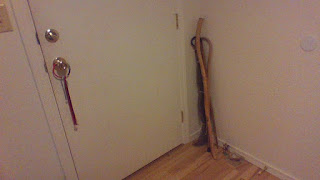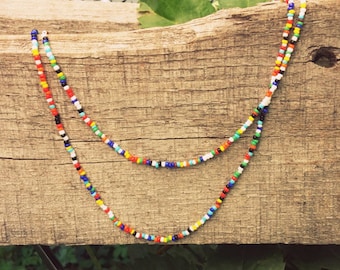Originally libations were poured upon the dirt ground. But since in many apartments and temples not being on ground level, people began to modify. Libations were then poured into a bucket, where they could pour outside after, or a few drops of water poured onto a clay tile (teja) in Yoruba faiths in the new world if it is prescribed by your reading. This was kept with an egun shrine near pipes leading to the ground such as in the bathroom or kitchen, usually with marigolds, flor de muerto: flower of the dead. Or was also kept outside by the back door and yard area.
This is also where a Baston de muerto can be placed, and can be indicated that you need to work with the dead this way through your readings, and which type of stick needed for example one or two faces, a skull, or snake can be featured. If the Orisha Oya is suspected to be close to a person, it may be recommended to get a stick or set up a boveda in a certain way. Oya or Yansa is a warrioress of the cemetary gate related to the dead in the new world and the river in Africa, and not death the reaper herself, but she is related to how death, Iku got brought to earth out of compassion, because of suffering, starvation and disease. The stick again is indicated in a reading, and may be relate to the mysteries of earth.
Other names in different traditions for this stick of the dead is Bakulu stick in Palo or Kumangongo. The stick must be taken from nature in a certain way. Sometimes a main staff that is prescribed from a special tree is needed, but the rama of Palo does not have a baston de muerto in their lineage otherwise.
The palo or baton de muerto: Opa or igi egun, pagugu, aumba, although Yoruban faith will add things to this altar like 9 bundles sticks of flor mar pacifico (hibiscus) with a red ribbon and approach their dead a different way than the Palero, Vodouisant or Espirista. The egun stick for eggungun, was the ancestral altar axis mundi, tree, between our world and the worlds of the spirits.
From auctions609 store
It is used for ancestral dead or other dead in the frame mostly and not spirit guides approached through spiritualism who are more elevated. In Yoruban spirituality, egun are the collective dead who are from different sources or types, such as some serve as guardians of a place, or initiatory dead. The egungun are technically also a subset of bloodline ancestors as far as I understand.
The dead are very important for many reasons, and without them there is no Orisha, the saying Iku Loba Ocha, the dead gave birth to the Orisha explains cosmology and from the Odu stories.
artwork by Marietjie Henning
The staff represents the creative generative power of the dead, and as a phallic wand you will see the Ghede Lwa Baron dance with of life and death. It is like a family tree. The wand is like the body of Dhamballa, as Moses turned his staff into a snake. It is generative and spiritual fire of the Ace of wands. Thus some say the baston helps to strengthen the connection with the dead, and male line of ancestors.
tvtropes.org
In Puertorican Vudu, the staff of the dead is linked to base of the poteau or poto mitan or palo majeur (pillar, Ceiba world tree of the peristyle, caye, badji or hounfor), Papa Loko, and Papa Legba's cane (from us to the Lwa). I keep mine against my boveda, or by Legba's cane at the front door. Likewise we may use a sacred tree for our repository and tie 7 ribbons on it for the 7 Jefe Lwa Misterios of Sanse.
In espiritismo or Sanse: The stick can be placed as an "outside" shrine, or boveda "astral", such as against a strong tree which can serve as your spirit repository. Astral doesn't mean in spanish what we think of in ceremonial magick as a lunar realm. It means outside in nature, or without a physical body. This area is usually marked and consecrated with a border of cascarilla chalk with 9 dashes or arrows. There can be kept ovoid river stones which are special repositories, otanes. To here you can place the items you normally would as a boveda such as white flowers and candles, multicolor bouquet, a sunflower, food offerings such as sweets, coffee, pork, fish, rice, stew, cigars, water, rum overnight.
from ibuocantomi@blogspot.com
The staff is tapped 9 times upon the ground to evoke and give notice, of vibrations to the ground where the dead of the world are connected, while giving orations and prayers and traditional songs to Egungun.
Some in Ocha have taboo on what a woman can do around Egun, such as they did not wear the costume according to pataki stories, they can have the stick but some do not strike the ground with it. The stick also banishes negativity, and some place bells apon the lengthy (almost to the ground) 9 colored ribbons or cloth strips tied at the top to ward off misfortune (osogbo). Some do not place the bells stating it scares off Egun, as there are different types of baston, some are built to remove the dead tapping from one area of the house leading to the outside of the dwelling. Some also just place one red ribbon to mark the staff is empowered by the dead. Can be multicolor beaded. The colored ribbons represent the egun dance dress costume, and as the number of the dead. The stick is straight, true as possible, and can be made of different or a specific type of woods.
Iku is the spirit of death itself
Not everyone should have this stick, which needs to be taken seriously. It will also be revealed to you if you are a medium, or have a spiritual court which deals more with the dead. You should have already begun a regular practice to attending to your ancestors.
army of darkness
However, you do not need to be initiated to get this stick, if you have guidance from a priest. The top can be drilled into, to pack the secrets into it and then sealed by a priest in Ifa with certain types. The stick is washed with different herbs and preperations, dedicated, consecrated, fed (animal blood in Ocha and Palo) and prayed over.
In Sanse, I do this with various herbs, washing, colognes, and epo (red palm oil) with a service to the dead. But if you are seriously entertaining entry to another tradition than Sanse, I recommend you get one in that tradition, as we are a syncretisation.
I have also received my Bakulu ancestor necklace from my godfather, a Palero. In Sanse we also use a multi-color glass or crystal seed bead necklace consecrated to the dead of your court.
If you would like either of these items, then you can contact our temple and start a consultation and rapport.
The staff can be used in misa, or in working the boveda in Espiritismo,
and marks the officiant in rites to the dead.
Sancista 7
crossroads
I have also received my Bakulu ancestor necklace from my godfather, a Palero. In Sanse we also use a multi-color glass or crystal seed bead necklace consecrated to the dead of your court.
Sanse:
We do not use the 7/7 pattern unless you have the 7 african powers as guides or are an initiate of Sanse for Los 7 Jefe Lwa in our house.
These items are sacred and must be cared for. The necklaces are not worn during sleep, in the water, nor during sexual activity, or out at the club, and should be kept in a special place, preferably wrapped in a white satin or silk panel of cloth and put away.
If you would like either of these items, then you can contact our temple and start a consultation and rapport.
A qualified Santero, Palero or Espiritsta can make you a Baston de muerto.
We currently offer these items to the Bakulu or your spiritual court: ancestors and dead.
Whatever your tradition you receive the stick in, influences where and how you will serve your dead, because these religions have a different group of ancestors spiritually. So a Bakulu stick is not placed at the Boveda.
We currently offer these items to the Bakulu or your spiritual court: ancestors and dead.
Whatever your tradition you receive the stick in, influences where and how you will serve your dead, because these religions have a different group of ancestors spiritually. So a Bakulu stick is not placed at the Boveda.
The staff can be used in misa, or in working the boveda in Espiritismo,
and marks the officiant in rites to the dead.
Sancista 7
crossroads
















No comments:
Post a Comment